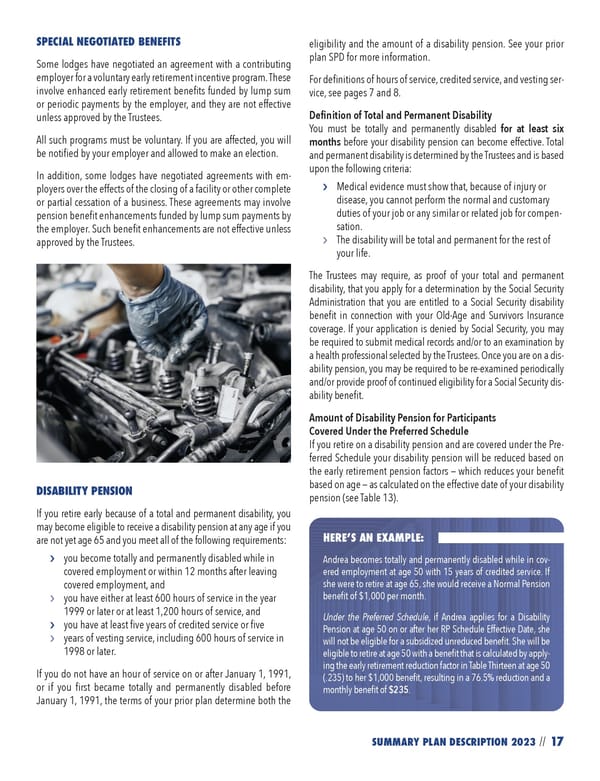17 SUMMARY PLAN DESCRIPTION 2023 // SPECIAL NEGOTIATED BENEFITS Some lodges have negotiated an agreement with a contributing employer for a voluntary early retirement incentive program. These involve enhanced early retirement benefits funded by lump sum or periodic payments by the employer, and they are not effective unless approved by the Trustees. All such programs must be voluntary. If you are affected, you will be notified by your employer and allowed to make an election. In addition, some lodges have negotiated agreements with em- ployers over the effects of the closing of a facility or other complete or partial cessation of a business. These agreements may involve pension benefit enhancements funded by lump sum payments by the employer. Such benefit enhancements are not effective unless approved by the Trustees. DISABILITY PENSION If you retire early because of a total and permanent disability, you may become eligible to receive a disability pension at any age if you are not yet age 65 and you meet all of the following requirements: › you become totally and permanently disabled while in covered employment or within 12 months after leaving covered employment, and › you have either at least 600 hours of service in the year 1999 or later or at least 1,200 hours of service, and › you have at least five years of credited service or five › years of vesting service, including 600 hours of service in 1998 or later. If you do not have an hour of service on or after January 1, 1991, or if you first became totally and permanently disabled before January 1, 1991, the terms of your prior plan determine both the eligibility and the amount of a disability pension. See your prior plan SPD for more information. For definitions of hours of service, credited service, and vesting ser- vice, see pages 7 and 8. Definition of Total and Permanent Disability You must be totally and permanently disabled for at least six months before your disability pension can become effective. Total and permanent disability is determined by the Trustees and is based upon the following criteria: › Medical evidence must show that, because of injury or disease, you cannot perform the normal and customary duties of your job or any similar or related job for compen- sation. › The disability will be total and permanent for the rest of your life. The Trustees may require, as proof of your total and permanent disability, that you apply for a determination by the Social Security Administration that you are entitled to a Social Security disability benefit in connection with your Old-Age and Survivors Insurance coverage. If your application is denied by Social Security, you may be required to submit medical records and/or to an examination by a health professional selected by the Trustees. Once you are on a dis- ability pension, you may be required to be re-examined periodically and/or provide proof of continued eligibility for a Social Security dis- ability benefit. Amount of Disability Pension for Participants Covered Under the Preferred Schedule If you retire on a disability pension and are covered under the Pre- ferred Schedule your disability pension will be reduced based on the early retirement pension factors — which reduces your benefit based on age — as calculated on the effective date of your disability pension (see Table 13). HERE’S AN EXAMPLE: Andrea becomes totally and permanently disabled while in cov- ered employment at age 50 with 15 years of credited service. If she were to retire at age 65, she would receive a Normal Pension benefit of $1,000 per month. Under the Preferred Schedule, if Andrea applies for a Disability Pension at age 50 on or after her RP Schedule Effective Date, she will not be eligible for a subsidized unreduced benefit. She will be eligible to retire at age 50 with a benefit that is calculated by apply- ing the early retirement reduction factor in Table Thirteen at age 50 (.235) to her $1,000 benefit, resulting in a 76.5% reduction and a monthly benefit of $235.
 2023 NPF Summary Plan Description Page 18 Page 20
2023 NPF Summary Plan Description Page 18 Page 20